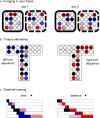On the Integration of Space, Time, and Memory
- PMID: 28858612
- PMCID: PMC5662113
- DOI: 10.1016/j.neuron.2017.06.036
On the Integration of Space, Time, and Memory
Abstract
The hippocampus is famous for mapping locations in spatially organized environments, and several recent studies have shown that hippocampal networks also map moments in temporally organized experiences. Here I consider how space and time are integrated in the representation of memories. The brain pathways for spatial and temporal cognition involve overlapping and interacting systems that converge on the hippocampal region. There is evidence that spatial and temporal aspects of memory are processed somewhat differently in the circuitry of hippocampal subregions but become fully integrated within CA1 neuronal networks as independent, multiplexed representations of space and time. Hippocampal networks also map memories across a broad range of abstract relations among events, suggesting that the findings on spatial and temporal organization reflect a generalized mechanism for organizing memories.
Keywords: CA1; CA3; entorhinal cortex; hippocampus; mixed selectivity; parahippocampal cortex; place cells; temporal context model; time cells.
Copyright © 2017 Elsevier Inc. All rights reserved.
Figures


References
-
- Aminoff E, Gronau N, Bar M. The parahippocampal cortex mediates spatial and nonspatial associations. Cereb Cortex. 2007;17:1493–1503. - PubMed
Publication types
MeSH terms
Grants and funding
LinkOut - more resources
Full Text Sources
Other Literature Sources
Medical
Miscellaneous

